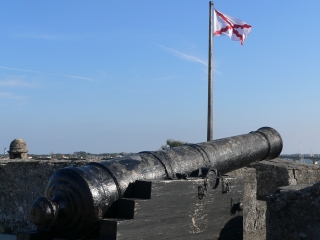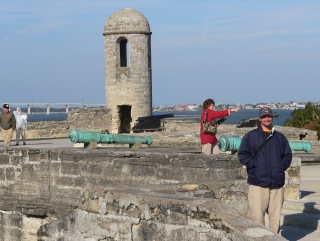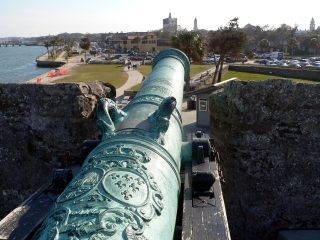NPS Website; Local Website
 WHAT IS IT?
WHAT IS IT?A massive stone-masonry 17th Century Spanish fort built to protect the city of St. Augustine from British colonial invasion. The Castillo de San Marcos (St. Mark’s Castle) marked the northern-most settlement in Spain’s vast New World Empire.
BEAUTY (8/10)
We were immediately struck by the Castillo de San Marcos’ tremendous size. Four diamond-shaped bastions jut out from the corners of a square interior. A dry moat surrounds the light grey walls that were built with the fragile rock, coquina. In small quantities, coquina crumbles when handled, but when packed together, the rock withstands cannonballs by sucking them in upon impact.
From atop the Fort you can see the beautiful blue waters of Matanzas Bay, the subtle curves of the Three Lions Bridge and the Old City Gates of St. Augustine, the oldest continually inhabited city in the United States.
HISTORICAL INTEREST (8/10)
Few American cities have as rich a history as St. Augustine, Florida. The Spanish founded the city in 1565 and it served as the capital of the Province of Florida for over 200 years. St. Augustine protected the Spanish trade routes and the flow of goods along the Gulf Stream and back to Spain. The city was Spain’s northernmost outpost in the New World.
Its frontier location necessitated the building of a great fort. Castillo de San Marcos began construction in 1672. In its lifetime, the Fort faced numerous attacks and sieges from the English. St. Augustine was burned a dozen times but the Spanish never lost the city due to the strength of the Castillo de San Marcos.
The Fort plays the starring role in stories told at other nearby National Park Sites: Fort Matanzas NM, Fort Caroline NMEM and to some extent Fort Frederica NM. St. Augustine was the center of life in the part of the world for nearly two centuries, Castillo de San Marcos was its protector.
CROWDS (7/10)
There were gobs and gobs of people at the Site even though, later that day, the narrow streets of St. Augustine did not seem crowded. Our guided tour included over 40 people who gravitated pre-tour to the Ranger while he answered one of our many questions. The large crowds did not hinder our visit; there are so many things to see.
 EASE OF USE/ACCESS (4/5)
EASE OF USE/ACCESS (4/5)The Site is located along the coast in the middle of old St. Augustine. It is one of the city’s most prominent landmarks. You can’t miss it. There are approximately 30 free parking spaces on Site but they fill up quickly. You can also park across the street in the St. Augustine Visitor Center lot. We stayed downtown at a nearby hotel and walked everywhere.
CONCESSIONS/BOOKSTORE (4/5)
Miniature metal soldiers guard the door. Reproductions of colonial and old world maps line the walls. If you are looking for tiny replicas of cannons or ammunition, you can find them here too. The bookstore and Castillo de San Marcos had plenty of books arranged by topic and souvenirs with a Spanish colonial bent. There was no need to supplement the offerings with Jamestown glassware and pottery. Pretty, but why not let the beauty of St. Augustine shine? In general, a great store.
COSTS (3/5)
Entry is $6 per person or free with a National Parks Pass. Your ticket is good for an entire week, which is helpful given the Fort’s many nooks and crevices that beg for exploration.
RANGER/GUIDE TO TOURIST RATIO (4/5)
Jacksonville could learn from its southern neighbor. St. Augustine was well prepared and doubly staffed for any Super Bowl crowd that might find its way here. Castillo de San Marcos NM had volunteers around every corner, as well as regular Ranger talks. We accidentally began the 3 pm talk early when a crowd gathered to hear one Ranger answer our barrage of questions we had been collecting since Fort Matanzas. The Ranger happily obliged.
TOURS/CLASSES (8/10)
The Park Service provides a 26-station self-guided walking trail through the fort’s extensive rooms and roofs. Many of these rooms also include exhibits that further detail their role. The amount of information is overwhelming.
Ranger-led talks are given hourly in the fort’s inner courtyard. The Ranger was near obsessive in his knowledge of Napoleonic warfare, the U.S. coastal defense system and colonial firearms. He was a welcome help in our attempt to understand and interrelate the five National Park Service forts along the Atlantic coast from Savannah, Georgia to St. Augustine. He helped cut through much of the confusion in ways that exhibit panels and timelines just do not.
On the weekends, the Rangers dress up in period costume and shoot cannons into the water four times a day. The Park Service offers many other interactive tours on site including a monthly torchlight tour, bird walks and reenactments.
FUN (8/10)
We arrived in St. Augustine late afternoon and were immediately drawn to the Castillo. Its size and elevation gave us a perfect vantage point to scope out the city and decide where we wanted to go next. Positioned on the waterfront at the end of a river walk, the Castillo caught the final rays of the sun that had finally decided to come out. We warmed ourselves on the bastions before ducking into the chilly hallways to check out the numerous displays.
The Ranger that led our talk kindly kept us in the sunny corner or the courtyard. Our knowledgeable guide spent equal time explaining the whys and whens of the French and Spanish incursions and dismissing the Hollywood versions of coastal battles. He conceded that Master and Commander was quite historically accurate with regards to warfare; but it was one of the few to get it right.
He went on to explain that in the past, the Park Service caved in to the historical inaccuracies of Hollywood. An Errol Flynn movie featured a fort that looked just like Castillo de San Marcos except that its moat was filled with water. 600 pounds (yes pounds!) of mail found its way to the Park Service, demanding that the San Marcos moat be hydrated.
Historians knew that the St. Augustine fort had a dry moat, but did not have the final say. Their word was heeded in the early 90’s when the moat was finally drained. The requested water had led to serious structural damage. The fort had weathered 500 years, twelve British sieges and millions of tourists but was most damaged by an Errol Flynn movie.
We’re suckers for trivia.
 WOULD WE RECOMMEND? (8/10)
WOULD WE RECOMMEND? (8/10)The town of St. Augustine still seems more like a Spanish colonial outpost than an American town. Both the Park Service Rangers and the period costumed employees of the Colonial Spanish Quarter Museum do a terrific job at perpetuating this feel. We loved the town’s Avenida de San Marcos, a pedestrian-only promenade, and its eclectic array of good restaurants. Comparable only to Williamsburg, Virginia, St. Augustine is a wonderful historical vacation spot. The stellar Castillo de San Marcos NM is large part of the town’s attractiveness.
TOTAL 62/80
www.usa-c2c.com
© 2004-06